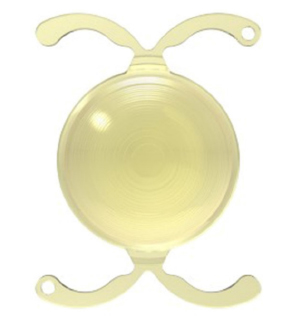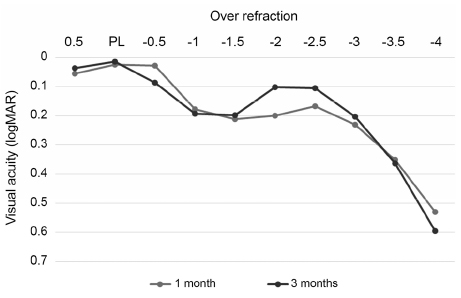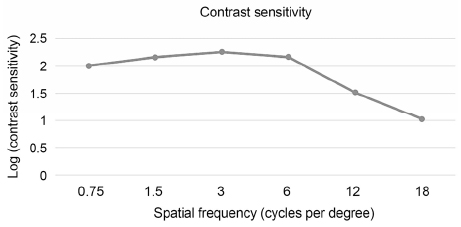J Korean Ophthalmol Soc.
2018 Feb;59(2):145-152. 10.3341/jkos.2018.59.2.145.
Clinical Outcomes of Diffractive Aspheric Trifocal Intraocular Lens Implantation
- Affiliations
-
- 1Department of Ophthalmology, HanGil Eye Hospital, Incheon, Korea. chobjn@empas.com
- 2Department of Ophthalmology, Catholic Kwandong University College of Medicine, Gangneung, Korea.
- KMID: 2403807
- DOI: http://doi.org/10.3341/jkos.2018.59.2.145
Abstract
- PURPOSE
To evaluate the clinical outcomes of patients with diffractive aspheric trifocal intraocular lens FineVision Pod F IOL (PhysIOL, Liège, Belgium) implantation.
METHODS
Thirty eight eyes received phacoemulsification and implantation of FineVision Pod F IOL. Uncorrected distant visual acuity (UDVA), uncorrected intermediate visual acuity (UIVA), uncorrected near visual acuity (UNVA), refractive values, and defocus curve were evaluated at postoperative 1 month and 3 months. Optical quality was evaluated with the contrast sensitivity test, OQAS® (Optical Quality Analysis System, Visiometrics, Cerdanyola del Vallès, Spain) and questionnaire.
RESULTS
At the 3-month postoperative follow-up, the mean spherical equivalent was 0.01 ± 0.31 D and the mean UDVA, UIVA and UNVA were 0.04 ± 0.07, 0.19 ± 0.12, and 0.04 ± 0.07, respectively. Mean contrast sensitivities at 0.75, 1.5, 3, 6, 12, and 18 cycles per degrees were 2.00 ± 1.54, 2.16 ± 1.60, 2.25 ± 1.76, 2.16 ± 1.83, 1.52 ± 1.47 and 1.03 ± 0.95 respectively and mean objective scatter index by OQAS® (Optical Quality Analysis System, Visiometrics) was 1.54 ± 0.74. In satisfaction analysis, general satisfaction with surgery was 89% and spectacle independence were 89% at far, 78% at intermediate and 83% at near distance. Postoperative dissatisfaction factors were dryness (36%), glare at night (32%), halo (18%).
CONCLUSIONS
The FineVision Pod F IOL showed excellent distant and near visual acuities with an effective intermediate visual acuity. The eyes with FineVision Pod F IOL expected to achieve the favorable visual outcome and patient satisfaction.
Keyword
MeSH Terms
Figure
Reference
-
1. Blaylock JF, Si Z, Vickers C. Visual and refractive status at different focal distances after implantation of the ReSTOR multifocal intraocular lens. J Cataract Refract Surg. 2006; 32:1464–1473.
Article2. Alfonso JF, Fernández-Vega L, Puchades C, Montés-Micó R. Intermediate visual function with different multifocal intraocular lens models. J Cataract Refract Surg. 2010; 36:733–739.
Article3. de Vries NE, Nuijts RM. Multifocal intraocular lenses in cataract surgery: literature review of benefits and side effects. J Cataract Refract Surg. 2013; 39:268–278.
Article4. Mester U, Hunold W, Wesendahl T, Kaymak H. Functional outcomes after implantation of Tecnis ZM900 and Array SA40 multifocal intraocular lenses. J Cataract Refract Surg. 2007; 33:1033–1040.
Article5. Woodward MA, Randleman JB, Stulting RD. Dissatisfaction after multifocal intraocular lens implantation. J Cataract Refract Surg. 2009; 35:992–997.
Article6. Lee HS, Park SH, Kim MS. Clinical results and some problems of multifocal apodized diffractive intraocular lens implantation. J Korean Ophthalmol Soc. 2008; 49:1235–1241.
Article7. Kim SM, Kim CH, Chung ES, Chung TY. Visual outcome and patient satisfaction after implantation of multifocal IOLs: three month follow-up results. J Korean Ophthalmol Soc. 2012; 53:230–237.8. Davison JA, Simpson MJ. History and development of the apodized diffractive intraocular lens. J Cataract Refract Surg. 2006; 32:849–858.
Article9. Kretz FT, Gerl M, Gerl R, et al. Clinical evaluation of a new pupil independent diffractive multifocal intraocular lens with a +2.75 D near addition: a European multicentre study. Br J Ophthalmol. 2015; 99:1655–1659.
Article10. Lee SC, Kim JW, Lim TH, et al. Clinical outcomes of diffractive aspheric trifocal intraocular lens implantation. J Korean Ophthalmol Soc. 2015; 56:1338–1344.
Article11. Sheppard AL, Shah S, Bhatt U, et al. Visual outcomes and subjective experience after bilateral implantation of a new diffractive trifocal intraocular lens. J Cataract Refract Surg. 2013; 39:343–349.
Article12. Cochener B, Vryghem J, Rozot P, et al. Clinical outcomes with a trifocal intraocular lens: a multicenter study. J Refract Surg. 2014; 30:762–768.
Article13. Marques EF, Ferreira TB. Comparison of visual outcomes of 2 diffractive trifocal intraocular lenses. J Cataract Refract Surg. 2015; 41:354–363.
Article14. Saad A, Saab M, Gatinel D. Repeatability of measurements with a double-pass system. J Cataract Refract Surg. 2010; 36:28–33.
Article
- Full Text Links
- Actions
-
Cited
- CITED
-
- Close
- Share
- Similar articles
-
- Clinical Outcomes of Diffractive Aspheric Trifocal Intraocular Lens Implantation
- Comparison of the Visual Outcomes after Cataract Surgery with Implantation of a Bifocal and Trifocal Diffractive Intraocular Lens
- Trifocal versus Bifocal Diffractive Intraocular Lens Implantation after Cataract Surgery or Refractive Lens Exchange: a Meta-analysis
- Clinical Outcomes of Diffractive Trifocal Intraocular Lens in Both Eyes: A 6-Month Follow-Up
- Effects of Bifocal versus Trifocal Diffractive Intraocular Lens Implantation on Visual Quality after Cataract Surgery




